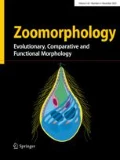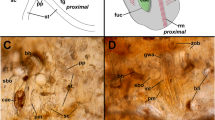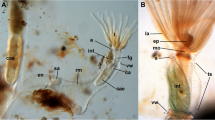Summary
Macrocilia are compound ciliary feeding organelles found inside the mouth of beroid ctenophores. Each macrocilium contains multiple 9+2 axonemes surrounded by a common membrane and bears a distinct capping structure at the distal end. The cap consists of extensions of axonemal microtubules that are embedded in an electron-dense matrix to form pointed projections or teeth. The teeth change from a straight to a hooked configuration during the beat cycle of macrocilia, and these changes in tip shape are thought to aid ingestion and/or breakup of prey. Using light and electron microscopy we found a remarkable diversity in macrociliary size, tooth pattern, and distribution among “traditional” morphospecies of Beroe. These differences distinguish two major groups of Beroida. Group 1 includes most of the described nominal species [B. cucumis, B. abyssicola, B. ovata, B. gracilis, and B. sp. (Gloria)]. Their macrocilia are relatively small (typically 25–30 μm long, 5 μm diameter) and are restricted to a band around the inside of the lips. Two main types of macrociliary tooth patterns are found: 3–12 equally-sized teeth [B. cucumis (Mon), B. ovata, B. sp. (Gloria)] or 3 teeth with the middle tooth being larger (B. cucumis (CC), B. gracilis) or smaller (B. abyssicola). Group 2 species (B. forskali, B. mitrata) have greatly flattened bodies and wide mouths. Their macrocilia cover an extensive area of the stomodaeal cavity, and are longer and stouter (80–100 μm long, 12–15 μm in diameter). The shaft of the macrocilium is not hexagonal in transverse section, as in Group 1 species, but is wedge-shaped, being broader on the recovery-stroke (oral) side. The macrociliary tips are blunt and finely serrated, bearing one or more rows of 10–12 short teeth running at right angles to the beat plane. This diversity in macrociliary patterns is apparently related to differences in diet, feeding methods, and/or mechanism of prey digestion among various species. However, direct evidence for the functional significance of macrociliary diversity has not yet been obtained. The macrociliary patterns may be useful for clarifying problems of species identification and relationships within the Beroida. In particular, macrociliary differences found between and within traditionally distinguished morphospecies of Beroe raise the possibility of the existence of complexes of sibling species in this group.
Similar content being viewed by others
References
Bigelow HB (1912) The ctenophores; “Albatross” expedition of 1904–1905. Bull Mus Comp Zool Harvard Coll 54:369–404
Chun C (1880) Der Ctenophoren des Golfes von Neapel, und der angrenzenden Meeres-Abschnitte. Engelmann, Leipzig, pp 1–311
Greve W (1970) Cultivation experiments on North Sea ctenophores. Helgol Wiss Meeresunters 20:304–317
Greve W, Stockner J, Fulton J (1976) Towards a theory of speciation in Beroe. In: Mackie GO (ed) Coelenterate ecology and behaviour Plenum Press, New York, pp 251–258
Harbison GR (1985) On the classification and evolution of the Ctenophora. In: Morris SC, George JD, Gibson R, Platt HM (eds) The origins and relationships of lower invertebrates. Clarendon Press, Oxford, pp 78–100
Harbison GR, Madin LP (1982) Ctenophora. In: Parker SP (ed) Synopsis and classification of living organisms, vol 1. McGraw-Hill, New York, pp 707–715
Harbison GR, Madin LP, Swanberg NR (1978) On the natural history and distribution of oceanic ctenophores. Deep-Sea Res 25:233–256
Horridge GA (1965) Macrocilia with numerous shafts from the lips of the ctenophore Beroe. Proc R Soc Lond B 162:351–364
Komai T (1918) On ctenophores of the neighbourhood of Misaki. Annot Zool Japon 9:450–474
Mortensen T (1927) Two new ctenophores. Vidensk Meddel Naturhist Foren 83:277–288
Moser F (1908) Japanesche Ctenophoren. Abh Math-Phys KL K Bayer, Akad Wiss Suppl-Bd i, Abh 4
Swanberg N (1974) The feeding behavior of Beroe ovata. Mar Biol 24:69–76
Tamm SL (1982) Ctenophores. In: Shelton GAB (ed) Electrical conduction and behaviour in simple' invertebrates. Oxford University Press, England, pp 266–358
Tamm SL (1988) Calcium activation of macrocilia in the ctenophore Beroe. J Comp Physiol 163:23–31
Tamm SL, Tamm S (1985) Visualization of changes in ciliary tip configuration caused by sliding displacement of microtubules in macrocilia of the ctenophore Beroe. J Cell Sci 79:161–179
Tamm SL, Tamm S (1987) Massive actin bundle couples macrocilia to muscles in the ctenophore Beroe. Cell Mot Cytoskel 7:116–128
Tamm S, Tamm SL (1988a) Development of macrociliary cells in Beroe. I. Actin bundles and centriole migration. J Cell Sci 89:67–80
Tamm SL, Tamm S (1988b) Development of macrociliary cells in Beroe. II. Formation of macrocilia. J Cell Sci 89:81–95
Tamm SL, Tamm S (1991) Reversible epithelial adhesion closes the mouth of Beroe, a carnivorous marine jelly. Biol Bull 181:463–474
Author information
Authors and Affiliations
Rights and permissions
About this article
Cite this article
Tamm, S.L., Tamm, S. Diversity of macrociliary size, tooth patterns, and distribution in Beroe (Ctenophora). Zoomorphology 113, 79–89 (1993). https://doi.org/10.1007/BF00403086
Received:
Issue Date:
DOI: https://doi.org/10.1007/BF00403086




